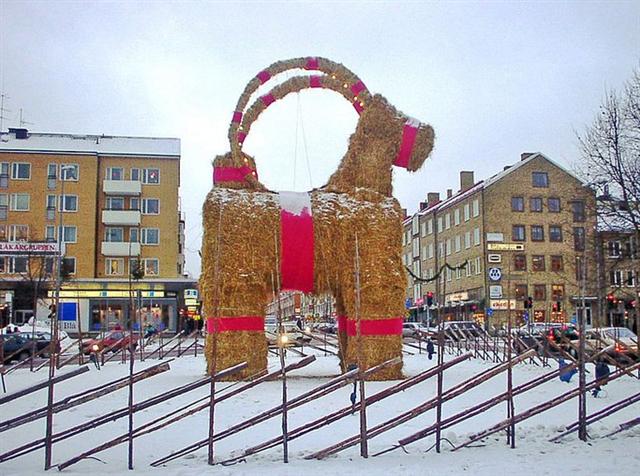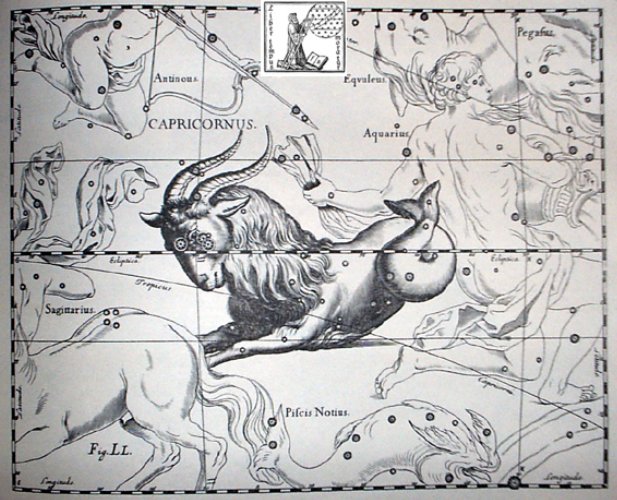Once again, once upon a
time the Goat probably
was a name for winter,
'the year in straw':

In the solar zodiac his
Sign was Capricornus, a
V-formed beast half on
'Land' and half in the
'Sea':

The end of the 'Old
Goat' meant spring had
arrived and down on
earth his portraits had to
vanish. The Yule Goat
above, a straw image
from Gävle in Sweden,
has a tradition where
people will sneak in and
burn him to ashes. This
is indeed the
appropriate action, to burn him
like
when the heat from
Spring Sun sucks up all
the leftover water
puddles.
Ancient mariners did not
look for Capricorn, they
instead looked at the
other end of the sky,
knowing that when the
Auriga constellation
rose in the night the
sailing season was
finished. The Charioteer
carried the old goat on
his back as a Sign that
winter was in the past:

The line for right
ascension 6h
corresponds to midsummer
and nowadays Auriga is
beginning around 5h.
Precession has carried
the constellations ahead
in the year but once
Capricornus would have
been around the
September equinox with
Auriga in February - the
last month of winter.
In rongorongo times
Capella (the 'Goat',
α Aurigae) rose heliacally
in June 7, much later
than the original date
for turning the
'Straw Goat'
to ashes:
|
Pleione
7 (21) |
8 |
9 |
|
June 6
(157) |
7 |
8 |
 |
 |
 |
|
Ca4-1
(77) |
Ca4-2 |
Ca4-3 |
| kua
tupu te rakau |
kua
tupu - te
kihikihi |
te hau tea |
| λ
Eridani (76.7) |
Rigel
(78.1),
Capella
(78.4) |
η
Scorpii (259.9) |
| Kihi
Kihikihi, lichen; also: grey,
greenish grey, ashen. Vanaga.
Kihikihi, lichen T, stone
T. Churchill.
The
Hawaiian day was divided in three general parts,
like that of the early Greeks and Latins, - morning,
noon, and afternoon - Kakahi-aka, breaking
the shadows, scil. of night; Awakea,
for Ao-akea, the plain full day; and
Auina-la, the decline of the day.
The lapse of the night, however, was noted by five
stations, if I may say so, and four intervals of
time, viz.: (1.) Kihi,
at 6 P.M., or about sunset; (2.) Pili,
between sunset and midnight; (3) Kau,
indicating midnight; (4.) Pilipuka, between
midnight and surise, or about 3 A.M.; (5.)
Kihipuka, corresponding to sunrise, or about 6
A.M. ... (Fornander) |
Kihi-kihi, the double
kihi, means the
opposite of sunset,
which also can be seen
in the picture at Ca4-2.
A new dawn is growing (kua
tupu).
Gredi (α
Capricorni) rose
heliacally in January
22, i.e. 5 months earlier:
|
Al Naam
7 |
8 |
9 |
10 (254) |
|
January
22 |
23 |
24 |
25
(390) |
 |
 |
 |
 |
|
Ca11-23 |
Ca11-24
(308) |
Ca11-25 |
Ca11-26 |
| te
inoino erua |
te hokohuki |
te moko |
|
Gredi
(307.2),
σ
Capricorni (307.5) |
Alshat
(307.9), Dabih (308.0), κ Sagittarii (308.1), Sadir
(308.4) |
Peacock
(308.7) |
Okul
(309.6), Bos (309.9), ο Capricorni (310.2) |
|
July 24 |
25 |
26 |
27 (208) |
|
Alhena 3 |
4 |
5 |
6 (72) |
|
Bright
Fire (125.4) |
Avior (126.4) |
ο
Ursa Majoris (127.4) |
θ
Cancri (128.2), η Cancri (128.5) |
June 7 (158) - January 22 (22) = 135 = 5 * 27.
The 'year in straw' lasted for 5 months and
the 'year in leaf' for 7 months. This seems to have been the case
also on Tahiti:
"... In Tahiti the
bread-fruit can be gathered for seven months, for the other
five there is none: for about two months before and after
the southern solstice it is very scarce, but from March to
August exceedingly plentiful. This season is called
pa-uru (uru = 'bread-fruit'). The recurring
scarcity of bread-fruit shewed the changes in the course of
the year, but the Pleiades afforded a surer limit.
In Samoa one authority gives the wet
season, ending in April, and the dry season, which comes to
an end with the palolo fishing in October; another
vaipalolo the palolo or wet season from October
to March, and toe lau, when the regular
trade-winds blow, embracing the other months; a third the
season of fine weather - in which however much rain falls in
some localities - and the stormy season, when it rains
heavily ..." (Martin P. Nilsson, Primitive
Time-Reckoning.)
|
Tahiti |
March - September |
pa-uru |
|
October
- February |
? |
|
Samoa |
May - October |
dry season |
|
November - April |
wet season |
|
Samoa |
April - September |
toe lau |
|
October - March |
vaipalolo |
The heliacal rising of
Auriga seems to have coincided with the
beginning of the 'year in leaf', the young
new year which ended the rule of the old
year 'in straw'. The old one went down in
the southwest (toga) while the new
one arrived with the wind from the northeast
(toke-rau). In Samoa the well ordered
trade-winds (toe lau) ruled from
April to September.
Rau (lau)
means leaf, the opposite of straw and a Sign
of plenty:
|
Rau
Rau 1.
(Also: raupá) leaf of a
plant, stem and leaves. 2.
Hundred: e tahi te rau, e rua
te rau, etc., 100, 200...
Also seems to have been used in
the meaning of 'many'. Tu'u
henua rau, someone who has
travelled to many countries
(such were called in the 19th
century natives who had
travelled abroad, employed as
sailors). Compare with: tai
raurau-á riki. Vanaga.
Rau
hei.
1. Branch of mimosa. 2. Killed
enemy. 3. Hanged 'fish'. 'Branche
du mimosa (signe de mort),
ennemie túe (poisson suspendu)'
according to Jaussen. Barthel.
Ra'u
1. To take something without the
owner's permission; to seize
something forcibly. 2. Ra'u
maahu, ancient expression,
literally: to appropriate the
steam (maahu) of the food
just taken out of an earth oven.
It refers to intruders coming to
help themselves uninvited.
Warriors off to a battle used to
be told: E ra'u maahu no koe,
o pagaha'a! meaning: 'Eat
little, lest you be heavy (and
lose your agility).' Vanaga.
1. Sa.:
la'u, to clear off, to carry
away; la'u mai, to
bring. Uvea: laku, to
send, to throw into. Ha.:
laulau, a bundle, a bag; a
wrapper of a bundle, the netting
in which food is carried;
lalau, to seize, to catch
hold of. 2. To.: lau,
lalau, lauji, to
pinch with the fingers, to nip.
Ha.: lau, to feel after a
thing; lalau, to extend
(as the hand), to seize, to
catch hold of. 3. Sa.: lau,
a leaf; lalau, to be in
leaf; laulau, a food tray
plaited from a coconut leaf, to
set out food on such a tray or
on a table. To.: lau,
lou, a leaf; laulau,
a tray. Fu., Uvea, Nuguria:
lau, a leaf. Niuē:
lau,
a leaf; laulau,
a table. Ha.: lau,
a leaf; laulau,
the netting in which food is
carried. Ma., Ta., Rarotonga,
Rapanui, Paumotu, Nukuoro,
Fotuna: rau,
a leaf. Mgv.: rau,
rou,
id. Mq.: au,
ou,
id. Churchill 2.
Ta.:
rauhuru,
dry banana leaf. Mq.:
auhuu,
id. (To.:
hulu,
leaves dry and dead.) Ha.:
lauhulu,
banana leaf. Churchill. |
Lau,
s.
Haw., to
feel for,
spread out,
expand, be
broad,
numerous;
s. leaf
of a tree or
plant,
expanse,
place where
people
dwell, the
end, point;
sc.
extension of
a thing; the
number four
hundred;
lau-kua,
to scrape
together, to
gather up
from here
and there
confusedly;
lau-la,
broad, wide,
extension,
width;
lau-na,
so associate
with, be
friendly;
lau-oho
(lit.
'leaves of
the head'),
the hair.
Tong.,
lau,
low,
spread out,
be broad,
exfoliate;
s.
surface
area;
lau-mata,
eyelash;
lo, a
leaf;
lo-gnutu,
the lips
(lit.
'leaves of
the mouth').
N. Zeal. and
Mang.,
rau,
spread,
expand;
raku-raku,
to scratch,
scrape.
Sam.,
lau,
leaf,
thatch, lip,
brim of a
cup,
breadth,
numeral
hundred
after the
first
hundred;
lau-a,
to be in
leaf,
full-leafed;
laua-ai,
a town, in
opposition
to the bush;
lau-ulu,
the hair of
the head;
launga-tasi,
even, level;
lau-lau,
to lay out,
spread out
food on a
table;
lau-tata,
a level
place on a
mountain or
at its foot;
lau-le-anga,
uneven;
lau-talinga,
the lobe of
the ear, a
fungus;
lau-tele,
large, wide,
common, of
people.
Tah., rau,
a leaf, a
hundred;
when
counting by
couples, two
hundred;
many
indefinitely;
rau-rau,
to scratch.
Fiji.,
lou,
leaves for
covering an
oven;
longa, a
mat, a bed
for
planting;
drau, a
leaf;
drau-drau,
leaves on
which food
is served
up, also a
hundred.
Saparua.,
laun,
leaf. Mal.,
daun,
id.;
luwas,
broad,
extended.
Sunda.,
Rubak., id.,
Amboyna,
ai-low,
id. Malg.,
rav,
ravin,
leaf;
ravin-tadign,
lobe of the
ear; lava,
long, high,
indefinite
expression
of
extension;
lava-lava,
eternal;
lava-tangh,
a spider.
The word
lau, in
the sense of
expanse, and
hence 'the
sea, ocean',
is not now
used in the
Polynesian
dialects.
There
remain,
however, two
compound
forms to
indicate its
former use
in that
sense:
lau-make,
Haw., lit.
the abating
or subsiding
of water,
i.e.,
drought;
rau-mate,
Tah., to
cease from
rain, be
fair
weather;
rau-mate,
N. Zeal.,
id., hence
summer.
The other
word is
koo-lau,
Haw.,
kona-rau,
N. Zeal.,
toe-rau,
Tah., on the
side of the
great ocean,
the weather
side of an
island or
group;
toa-lau,
Sam., the
north-east
trade wind.
In Fiji,
lau is
the name of
the windward
islands
generally.
In the Malay
and
pre-Malay
dialects
that word in
that sense
still
remains
under
various
forms:
laut,
lauti,
lautan,
lauhaha,
olat,
wolat,
medi-laut,
all
signifying
the sea, on
the same
principle of
derivation
as the Latin
æquor,
flat, level,
expanse, the
sea.
Welsh,
llav, to
expand;
lled,
breadth.
Armor.,
blad,
flat, broad.
Lat.,
latus,
broad, wide,
spacious.
Greek,
πλατυς,
wide, broad,
flat;
πλατη,
broad
surface,
blade of an
oar;
πλακοσ,
broad, flat.
Pers., lâtû,
blade of an
oar, oar.
Lith.,
platus,
flat.
Sanskr.,
prath,
be extended,
to spread.
Goth.,
laufs or
laubs,
a leaf.
Icel.,
laug,
bath;
lauga,
to bathe,
lögr,
the sea,
water,
moisture.
Bearing in
mind l
and n
are
convertible
in the West
Aryan as in
the
Polynesian
dialects, we
might refer
to the
following as
original
relatives of
the
Polynesian
lau:
Sanskr.,
nau,
boat, ship;
snâ,
and its
connections,
'to bathe'.
Greek,
ναω, to
flow, float;
ναω,
νεω,
to swim, to
spin;
νευσις,
s.
swimming;
ναυς,
ship, &c.
Lat.,
no-are,
to swim,
float.
A.-Sax.,
naca,
id. O.
Norse,
snäcka,
a shell,
sobriquet of
boats and
vessels.
Perhaps the
Gothic
snaga, a
garment.
Liddell and
Scott and
also Benfey
refer the
Greek νεω
and
Latin neo,
'to spin',
to the
Sanskrit
nah, 'to
bind, tie'.
With due
deference, I
would
suggest that
the
underlying
sense of 'to
bind' and
'tie' is 'to
shorten,
contract, to
knit' -
necto,
nodus
- and that
the original
conception
of 'to spin'
was one of
extension,
lengthening,
as
represented
in the
Polynesian
lau.
(Fornander)
|
|





